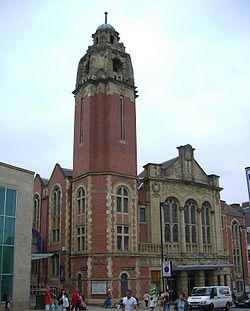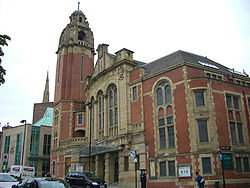
Victoria Hall, Sheffield
Encyclopedia



Methodism
Methodism is a movement of Protestant Christianity represented by a number of denominations and organizations, claiming a total of approximately seventy million adherents worldwide. The movement traces its roots to John Wesley's evangelistic revival movement within Anglicanism. His younger brother...
place of worship situated on Norfolk Street in Sheffield
Sheffield
Sheffield is a city and metropolitan borough of South Yorkshire, England. Its name derives from the River Sheaf, which runs through the city. Historically a part of the West Riding of Yorkshire, and with some of its southern suburbs annexed from Derbyshire, the city has grown from its largely...
city centre
Sheffield City Centre
Sheffield City Centre—often just referred to as town—is a district of the City of Sheffield, and part of the Sheffield Central ward. It includes the area that is within a radius of roughly of Sheffield Cathedral, and is encircled by the Inner Ring Road—a circular route started in the late 1960s...
. It is the most important Methodist building in Sheffield and it is a Grade II listed building. It is a large many roomed building which stands between the side streets of Chapel Walk and George Street. Although the main entrance to the church is on Norfolk Street, there is a separate administration entrance on Chapel Walk.
Original chapel
The present day Victoria Hall stands on the site of the previous Norfolk Street Wesleyan Chapel opened and consecrated in 1780 by John WesleyJohn Wesley
John Wesley was a Church of England cleric and Christian theologian. Wesley is largely credited, along with his brother Charles Wesley, as founding the Methodist movement which began when he took to open-air preaching in a similar manner to George Whitefield...
, who described it as “One of the largest in the Kingdom” and presented the new building with a set of silver communion vessels. Despite substantial renovation and the introduction of new vestries in 1875 at a cost of £6,000, the building was demolished in 1906 to make way for a more distinguished and larger structure. The old building was closed for the last time on May 13th 1906.
New hall built
On September 26th 1906 the foundation stone for the new Victoria Hall was laid followed by a celebratory lunch at the Cutlers Hall. The Hall was opened on Thursday September 24th 1908 with the final cost being in excess of £40,000, a huge sum at the time, but the Wesleyan mission cleared the debt within three years. The total expenditure included the outlay for extra land, with Sheffield entrepreneur Thomas Cole donating land for an enlarged site for the new church . The new Hall was originally designed by Waddington Son & Dunkerley but much of the design was re-worked by William John Hale (1862-1929) in 1908. Hale blended GothicGothic architecture
Gothic architecture is a style of architecture that flourished during the high and late medieval period. It evolved from Romanesque architecture and was succeeded by Renaissance architecture....
and Arts and Crafts
Arts and Crafts movement
Arts and Crafts was an international design philosophy that originated in England and flourished between 1860 and 1910 , continuing its influence until the 1930s...
styles and was instrumental in designing the large Baroque
Baroque architecture
Baroque architecture is a term used to describe the building style of the Baroque era, begun in late sixteenth century Italy, that took the Roman vocabulary of Renaissance architecture and used it in a new rhetorical and theatrical fashion, often to express the triumph of the Catholic Church and...
top to the tower. The carved decorations on the hall are by Alfred and William Tory and portrayals of the Wesley brothers are integrated into the design.
The new hall was part of the Forward Movement of the Methodist church inspired by Hugh Price Hughes
Hugh Price Hughes
Hugh Price Hughes , was a Welsh Christian theologian in the Methodist tradition. He was the founder of the Methodist Times and the first superintendent of the West London Methodist Mission, a key Methodist organisation today...
who called for a national religion which preached to the poor and resulted in the building of Central Halls in most of Britain’s large cities. One of the Hall’s first accomplishments was to set up the Sheffield Mission Labour Yard in Joiner Lane off The Wicker. This tackled the high level of unemployment of the time and by June 1909 had provided 5,903 days work to almost 6,000 men. The yard closed in 1915 as World War I
World War I
World War I , which was predominantly called the World War or the Great War from its occurrence until 1939, and the First World War or World War I thereafter, was a major war centred in Europe that began on 28 July 1914 and lasted until 11 November 1918...
reduced unemployment to virtually nil. The Hall has always had strong connections with Trade Unionism
Trade union
A trade union, trades union or labor union is an organization of workers that have banded together to achieve common goals such as better working conditions. The trade union, through its leadership, bargains with the employer on behalf of union members and negotiates labour contracts with...
and in September 1909 the Trade Union Congress held its annual conference at the hall, since then various unions have held meetings there. In the Hall’s early days the surrounding area was densely populated and thousands of young people attended Sunday School
Sunday school
Sunday school is the generic name for many different types of religious education pursued on Sundays by various denominations.-England:The first Sunday school may have been opened in 1751 in St. Mary's Church, Nottingham. Another early start was made by Hannah Ball, a native of High Wycombe in...
, Scouting
The Scout Association
The Scout Association is the World Organization of the Scout Movement recognised Scouting association in the United Kingdom. Scouting began in 1907 through the efforts of Robert Baden-Powell. The Scout Association was formed under its previous name, The Boy Scout Association, in 1910 by the grant...
, Girl Guides
Girlguiding UK
Girlguiding UK is the national Guiding organisation of the United Kingdom. Guiding began in the UK in 1910 after Robert Baden-Powell asked his sister Agnes to start a group especially for girls that would be run along similar lines to Scouting for Boys. The Guide Association was a founder member of...
and Boys Brigade.
Wartime
During World War I the Hall opened its doors to care for the members of the armed forces and after the end of the conflict the Hall received a visit from King George VGeorge V of the United Kingdom
George V was King of the United Kingdom and the British Dominions, and Emperor of India, from 6 May 1910 through the First World War until his death in 1936....
and Queen Mary
Mary of Teck
Mary of Teck was the queen consort of the United Kingdom and the British Dominions, and Empress of India, as the wife of King-Emperor George V....
during their visit to Sheffield in 1919. The king presented medals to the returning soldiers from the platform in the sanctuary
Sanctuary
A sanctuary is any place of safety. They may be categorized into human and non-human .- Religious sanctuary :A religious sanctuary can be a sacred place , or a consecrated area of a church or temple around its tabernacle or altar.- Sanctuary as a sacred place :#Sanctuary as a sacred place:#:In...
. During the years of the Great Depression
Great Depression
The Great Depression was a severe worldwide economic depression in the decade preceding World War II. The timing of the Great Depression varied across nations, but in most countries it started in about 1929 and lasted until the late 1930s or early 1940s...
the Hall served free breakfasts to needy children and distributed food parcels as well helping the unemployed. Prior to the completion of the Sheffield City Hall
Sheffield City Hall
Sheffield City Hall is a Grade II* listed building in Sheffield, England, containing several venues, ranging from the Oval Concert Hall which seats over 2,000 people to a ballroom featuring a sprung dance floor...
in 1932, the Victoria Hall was the leading concert venue in the city with many leading orchestras playing concerts there. In World War II
World War II
World War II, or the Second World War , was a global conflict lasting from 1939 to 1945, involving most of the world's nations—including all of the great powers—eventually forming two opposing military alliances: the Allies and the Axis...
the hall survived the Sheffield Blitz
Sheffield Blitz
The Sheffield Blitz is the name given to the worst nights of German Luftwaffe bombing in Sheffield, England during the Second World War. It took place over the nights of 12 December and 15 December 1940....
air raids of December 1940, with The Messiah
Messiah (Handel)
Messiah is an English-language oratorio composed in 1741 by George Frideric Handel, with a scriptural text compiled by Charles Jennens from the King James Bible and the Book of Common Prayer. It was first performed in Dublin on 13 April 1742, and received its London premiere nearly a year later...
being sung to an audience of over 200 people on the Sunday after the raids. On May 9th 1941 part of Victoria Hall was converted into a rest hostel for the Forces with 20 beds, this was later expanded to 35 beds.
Present day
Today the hall stands in an important position in the city centre, across from Tudor SquareTudor Square
Tudor Square is a city square in the city of Sheffield, England. The square is home to the largest concentration of theatres in the UK outside London and has thus become known as Sheffield’s ‘Theatre Land’...
and close to the Crucible
Crucible Theatre
The Crucible Theatre is a theatre built in 1971 and located in the city centre of Sheffield, South Yorkshire, England. As well as theatrical performances, it is home to the most important event in professional snooker, the World Snooker Championship....
and Lyceum
Lyceum Theatre (Sheffield)
-History:Built in 1897 following a traditional proscenium arch design, the Lyceum is the only surviving theatre outside of London designed by the famous theatre architect W.G.R. Sprague and the last example of an Edwardian auditorium in Sheffield...
theatres. As well as a place of worship, the Hall is used by various voluntary organisations including meals for the homeless. It is a popular venue for classical music concerts and the function room is available for hire by the general public. There is a coffee morning between 10.00 am and 12.00 Monday to Saturday.

